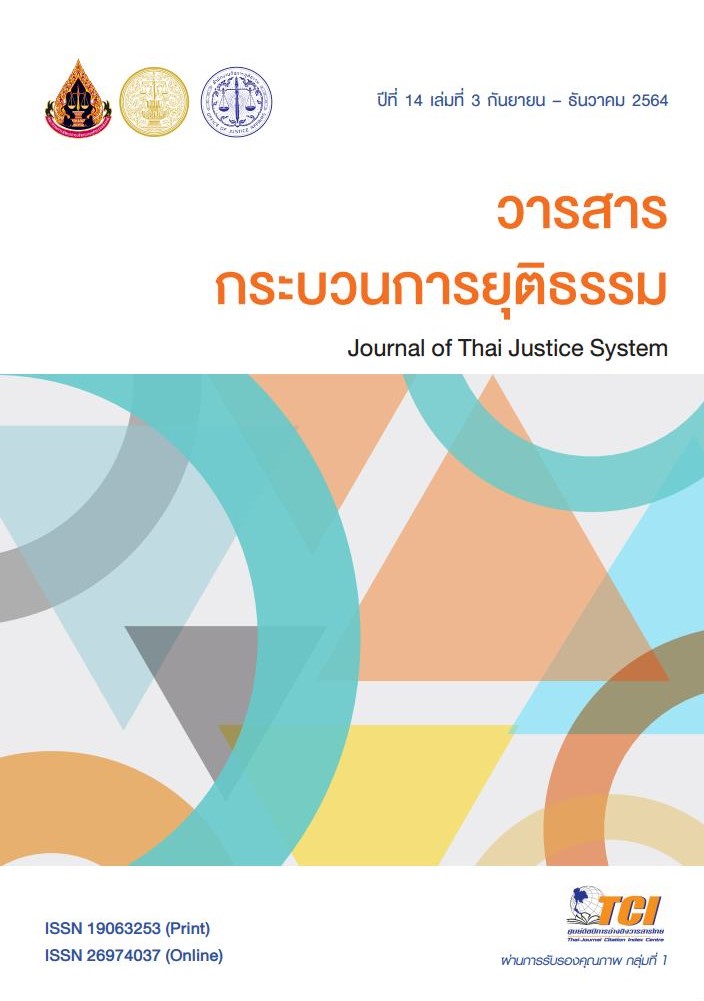การศึกษาลักษณะทางสัณฐานวิทยาของผลึกยานอนหลับโดยเทคนิคไมโครคริสตัลไลน์
Main Article Content
บทคัดย่อ
งานวิจัยนี้มีวัตถุประสงค์เพื่อศึกษาลักษณะทางสัณฐานวิทยาของผลึกยานอนหลับโดยใช้เทคนิคไมโครคริสตัลไลน์ และความเข้มข้นของสารตัวทำปฏิกิริยา ระยะเวลาที่เหมาะสม และเปรียบเทียบความแตกต่างของผลึกยานอนหลับ จำนวน 6 ชนิด ได้แก่ Alprazolam, Amitriptyline, Clorazepate, Circadin, Lorazepam และ Zolpidem และใช้สารตัวทำปฏิกิริยา(Reagent) จำนวน 2 ชนิด คือ โซเดียมคาร์บอเนต (Na2CO3) และโพแทสเซียมไอโอไดด์ (KI) จากการศึกษาพบว่า โซเดียมคาร์บอเนตใช้ช่วงความเข้มข้น 1%, 5% และ 10% ความเข้มข้นที่เหมาะสม คือ 1% Alprazolam มีลักษณะผลึกแบบกระจุก Amitriptyline มีลักษณะผลึกแบบปลายประสาท Clorazepate มีลักษณะผลึกแบบทรงกลมคล้ายหยดน้ำ Circadin มีลักษณะคล้ายก้านของต้นไม้ Lorazepam เป็นรูปพัดเล็ก และ Zolpidem เป็นรูปมัด และมีคุณสมบัติทางแสงแบบแอนไอโซทรอปิค (Anisotropic) ส่วนโพแทสเซียมไอโอไดด์ใช้ช่วงความเข้มข้น 1%, 3% และ 5% ความเข้มข้นที่เหมาะสมมีความแตกต่างกัน Alprazolam เป็นผลึกใสสี่เหลี่ยมขอบมน Amitriptyline เป็นผลึกใสคล้ายคริสตัลหกเหลี่ยมโปร่งแสง Clorazepate เป็นผลึกทรงกลมคล้ายหยดน้ำ Circadin ผลึกใสรูปสี่เหลี่ยม Lorazepam เป็นผลึกรูปสามเหลี่ยมมีหาง และ Zolpidem เป็นผลึกรูปสี่เหลี่ยมจัตุรัส โดย Alprazolam, Amitriptyline และ Lorazepam เป็นไอโซทรอปิค (Isotropic) ดังนั้น การตรวจเบื้องต้นด้วยเทคนิคนี้ เป็นเทคนิคที่ควรให้ความสำคัญและพัฒนา ทดลองกับการสารตัวอย่างที่เป็นสารเสพติดหรือสารชนิดอื่นเพื่อเป็นฐานข้อมูลต่อไป
Article Details
ต้นฉบับที่ได้รับการตีพิมพ์ในวารสาร เป็นลิขสิทธิ์ของวารสารกระบวนการยุติธรรม แต่ความคิดเห็นที่ปรากฏในเนื้อหาของบทความในวารสารกระบวนการยุติธรรม ถือเป็นความรับผิดชอบของผู้เขียนแต่เพียงผู้เดียว
เอกสารอ้างอิง
ชาคริต หริมพานิช. (2563). วิธีรักษาอาการนอนไม่หลับ ด้วยหลักทางการแพทย์. ค้นเมื่อ 20 สิงหาคม 2563, จาก https://www.honestdocs.co/insomnia-psychiatric-disorders-sleep-deprivation
ณปภา สิริศุภกฤตกุล, ชมพูนุท นุตสถาปนา และบงกช พันธ์บูรณานนท์. (2559). การตรวจพิสูจน์และยืนยันเอกลักษณ์ยานอนหลับชนิดใหม่ในประเทศไทย: ฟีนาซีแพมในของกลาง.วารสารกรมวิทยาศาสตร์การแพทย์. 58(3), 208-220.
ไทยรัฐออนไลน์. (2562). นักศึกษาสาวยัน เยลลี่ฟรอยด์ส่งกับมือ ผลตรวจออกแล้วเจือปนสาร กัญชา. ค้นเมื่อ 21 สิงหาคม 2562, จาก https://www.thairath.co.th/news/local/bangkok/1707985
นิโลบล บุญกระจ่าง และธิติ มหาเจริญ. (2561). การศึกษาลักษณะทางสัณฐานวิทยาของผลึกยาลดน้ำหนัก
โดยเทคนิคไมโครคริสตัลไลน์. Veridian E-Journal, 5(3), 41-52.
พิเชฐ อุดมรัตน. (2544). การใช้ยา benzodiazepine. ค้นเมื่อ 22 สิงหาคม 2563, จาก
https://med.mahidol.ac.th/ramamental/sites/default/files/public/pdf/BZD.PDF
โพสต์ทูเดย์. (2562). “ยาเสียสาว-เสียหนุ่ม GHB" ภัยมืดที่อาจมากับความสนุก. ค้นเมื่อ 22 สิงหาคม 2563, จาก https://www.posttoday.com/social/general/601217
ศุภลักษณ์ หนูสาย. (2560). “การศึกษาลักษณะทางสัณฐานวิทยาของผลึกของสารประกอบวัตถุ ระเบิด โดยวิธี Microcrystalline” วิทยานิพนธ์วิทยาศาสตรมหาบัณฑิต. โรงเรียนนายร้อยตำรวจ.
สรยุทธ วาสิกนานนท์. (2543). ยานอนหลับและสารช่วยการนอนหลับ. วารสารสมาคมจิตแพทย์แห่งประเทศไทย, 45(1), 89-97.
หนังสือต่างประเทศ
Bell, S. C., Oldfield, L. S., Shakleya, D. M., Petersen, J. L., & Mercer, J. W. (2006). Chemical composition and structure of the microcrystals formed between silver(I) and gamma-hydroxybutyric acid and gamma-hydroxyvaleric acid. Journal of forensic sciences, 51(4), 808-811.
Clarke, E. G. C. (1970). Isolation and identification of drugs in pharmaceuticals. Body fluids, and post-mortem material. Journal of Medicinal Chemistry, 13(2), 338-338.
Elie, M. P., & Elie, L. E. (2009). Microcrystalline tests in forensic drug analysis. Encyclopaedia of Analytical Chemistry. USA: John Wiley & Sons.
Elie, L. E., Baron, M. G., Croxton, R. S., & Elie, M.P. (2011a). Reversing microcrystalline tests:an analytical approach to recycling of microcrystals from drugs of abuse. Forensic science international, 207(1-3), 55-8.
Elie, L. E., Baron, M. G., Croxton, R. S., & Elie, M.P. (2011b). “Microcrystalline identification of selected designer drugs.” Forensic Science International. 214(1-3), 182-188.
Hannah, C. N., Elizabeth, A. G., & Matteo, D. (2011). Microcrystal analysis of cocaine hydrochloride and added adulterants. J Forensic Sci, 56(3), 736-740.
Patel, f., & Panday, A. (2015). Microcrystal Tests for Detection of Nicotine in Hookah Bar Samples. IJSRST, 1(2), 37-41.
PubChem. (2019a). Alprazolam. Retrieved August 30, 2020. from https://pubchem.ncbi.nlm.nih.gov/compound/2118
PubChem. (2019b). Amitriptyline. Retrieved August 30, 2020. from https://pubchem.ncbi.nlm.nih.gov/compound/2160
PubChem. (2019c). Clorazepate. Retrieved August 30, 2020. from https://pubchem.ncbi.nlm.nih.gov/compound/2809
PubChem. (2019d). Lorazepam. Retrieved August 30, 2020. from https://pubchem.ncbi.nlm.nih.gov/compound/3958
PubChem. (2019e). Melatonin. Retrieved August 30, 2020. from https://pubchem.ncbi.nlm.nih.gov/compound/896
PubChem. (2019f). Zolpidem. Retrieved August 30, 2020. from https://pubchem.ncbi.nlm.nih.gov/compound/5732
Silletti, D. K. (2013). Development of a microcrystal test for the detection of clonazepam. Chicago: University of illinois.
Stephen, C., & Sukhjeet, L. (1998). Hypnotics and sedatives. Side Effects of Drugs Annual, 21, 37-41.


